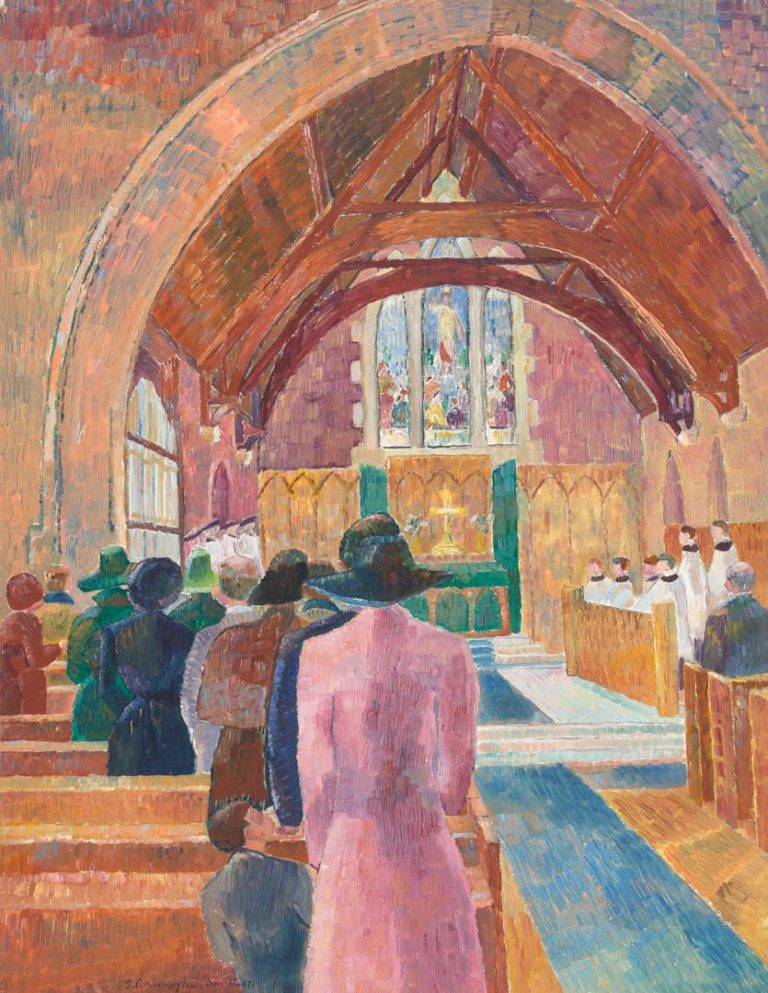We acknowledge the Traditional Owners of the land on which the Queensland Art Gallery | Gallery of Modern Art stands and recognise the creative contribution First Australians make to the art and culture of this country.

Grace Cossington Smith / Australia 1892–1984 / Church interior c.1941–42 (inscr. 1937) / Oil with pencil on pulpboard / 55.2 × 42.2cm / Purchased 2001 with funds raised through The Grace Cossington Smith Queensland Art Gallery Foundation Appeal / Collection: Queensland Art Gallery | Gallery of Modern Art / © Estate of Grace Cossington Smith
Grace Cossington SmithChurch interior c.1941–1942
On Display: QAG, Gallery 12
Church interior holds a special place in Grace Cossington Smith’s art practice as one of a small, important group of works she painted with a religious theme. The painting incorporates her major stylistic approaches and interests, and also encapsulates her concern with colour.
Painted in the early 1940s, Church interior indirectly references World War Two and has both sacred and secular significance: young men of enlistment age are notably absent from the congregation. As such, Cossington Smith — a patriot who was actively involved in the war effort — alludes to the impact of the conflict on the homefront.
Church interior is also meaningful in terms of the artist’s personal history, as it depicts the Smith family’s place of worship — the then new St James Anglican Church in Turramurra, Sydney, built in 1941.
Grace Cossington Smith played a leading role in the development of early-twentieth-century art in Australia. Born in Sydney, Cossington Smith’s childhood fascination with drawing was encouraged by her family, and from 1910, she received instruction from influential artist and teacher Anthony Dattilo Rubbo.
In 1912, Cossington Smith and her sister, Mabel, left Australia for England, where Grace attended drawing lessons at the Winchester School of Art. After returning to Australia, she resumed studies with Rubbo, whose advocacy for colour and pattern inspired Cossington Smith and her fellow students Norah Simpson, Roy de Maistre and Roland Wakelin. Her chief interest was colour and the way it could embody a pure, singing quality as well as a spiritual quality, which she saw in the world around her. Cossington Smith employed her knowledge of colour theory in her composition of the picture plane, combining the illusion of depth with a flattening of space.
She exhibited regularly throughout her career but her work was not widely known — or its significance appreciated — until the last decades of her life. In 1971, a retrospective of her work was shown in Sydney before touring nationally. Grace Cossington Smith received an Order of the British Empire and was made an Officer of the Order of Australia for her service to the visual arts.
Discussion Questions
1. The figures in Cossington Smith’s work draw our focus to the centre of the church. How does the artist achieve this ‘view’?
2. How does this painting give us a visual record of life in 1941? Has society changed in Australia since then? Consider religion and gender.
Activities
1. Study images of interiors of churches and places of worship. At the centre point, draw an altar, a dais or a platform. Use an arch to connect one side to the other. Consider various historical floor patterns in churches and, using these as references, design an ornate pattern for your floor.
2. Photograph or sketch the interior of a building in your school, or in your local area. Consider who uses the space. Create a painting of an interior that conveys a statement about society.